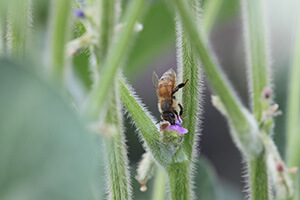
Midwestern corn and soy landscapes can be good for bees when native prairie habitat is included.
If you live in the Midwest, or anywhere else where corn and soy dominate the landscape, you’re aware of what a “green desert” looks like. It’s a landscape that’s filled with single-species monocultures of plants that provide bountiful food for humans, but very little food for bees during most of the growing season.
As the human population continues to grow, we’re seeing more and more of these landscapes as our increasing demand for food production wins out over native habitat. Furthermore, as farm technologies for insect and weed management become more efficient, there’s the potential for non-target insecticide exposures and fewer flowering weeds in agricultural landscapes. Both of these factors can add additional stress on bees.f you live in the Midwest, or anywhere else where corn and soy dominate the landscape, you’re aware of what a “green desert” looks like. It’s a landscape that’s filled with single-species monocultures of plants that provide bountiful food for humans, but very little food for bees during most of the growing season.
But just how bad are corn and soy landscapes for honey bees? And what if we stopped planting every square inch of the Midwest with corn and soy? Could honey bees thrive in “green deserts” if they also had access to “watering holes of native prairies”? These are the topics for our twenty-seventh “Notes from the Lab,” where we highlight “Native habitat mitigates feast-famine conditions faced by honey bees in an agricultural landscape,” written by Adam Dolezal and colleagues and published in the journal Proceedings of the National Academy of Sciences of the United States of America (2019).
For their study, Dolezal and colleagues set out to test how honey bee colonies performed in one of the most intensively farmed areas in the world: Iowa. Iowa is dominated by agriculture, with 73% of the state’s land planted in annual crops such as corn and soy, and 93% of the state dedicated to some form of agriculture. Despite this dominance of agriculture, the remaining non-cropped portions of the land surrounding soybean fields have been shown to positively influence insect communities within those fields. Thus, Dolezal and colleagues were interested in testing whether the amount of this non-cropped land surrounding soybean and corn fields (i.e. cultivated cropland) also impacted honey bee colony performance.
The authors set up multiple apiaries adjacent to commercial soybean fields that were either surrounded by a majority of cultivated cropland within the typical flight radius of honey bees (84% corn and soybean; “high cultivation” areas) or a minority of cropland (38% corn and soybean; “low cultivation” areas). The other types of land surrounding the crops included woodland, grass/pasture, and urban development. They monitored the colonies every two weeks throughout the growing season (May-October), recording colony weight, adult and brood populations, lipid content in nurse bees, and pollen collected by foragers.
Because they noticed the striking pattern that colony weight and other performance metrics always decreased in the second half of the summer (in both the low and high cultivation areas), co-lead author Ashley St. Clair (a PhD student at the time) conducted a follow-up experiment. For this experiment, as colony weight started to decline in July, they moved half of the colonies to prairie habitats while the other half were kept at an apiary in cultivated land. They monitored total colony weight and lipid content of nurse bees within each group of colonies through the end of September.
So, what did they find? Did the colonies in low cultivation areas perform better than colonies in high cultivation areas? No and yes. In the first half of summer (May, June and July), colonies in landscapes with low cultivation gained less weight and had a lower rate of growth than colonies surrounded by high cultivation (compare the orange and purple bars on the left side of Fig. 1). This resulted in fewer bees in the colonies in low cultivation areas compared to high ….


